Relational Model¶
A relational database is a collection of one or more relations, which are based on the relational model.
Example
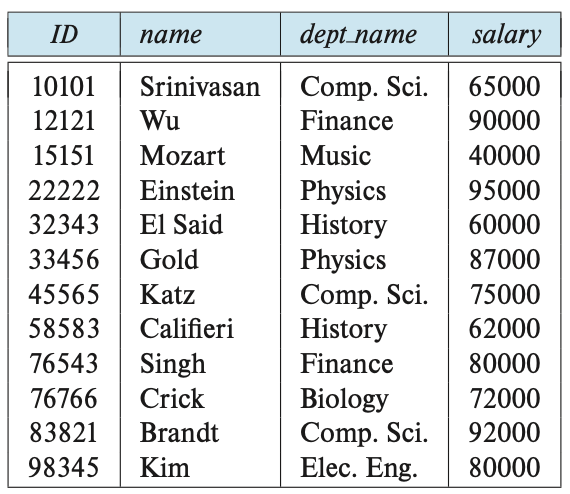
Structure of Relational Databases¶
Basic Structure¶
设集合 \( D_1, D_2, \ldots, D_n \),关系 \(r\) 是笛卡尔积 \(D_1 \times D_2 \times \ldots \times D_n\) 的一个子集。
Attribute Types¶
设关系 \(r\) 为元组 \( (a_1, a_2, \ldots, a_n) \),其中 \(a_i\) 是属性,\(D_i\) 是属性的域。每个属性都有名称。
关系理论第一范式
Attribute values are (normally) required to be atomic. 属性值是原子的,即无法分割。例如复合属性或者多值属性都不能成为关系的属性。
\( \mathsf{null} \) 属于每个域。
Concepts about Relation¶
A relation is concerned with two concepts: relation schema and relation instance. 关系包含两个概念:关系模式和关系实例。
-
Relation Schema: describes the structure of the relation.
Example
Student_schema = (sid: string, name: string, sex: string, age: int, dept: string)or
Student_schema = (sid, name, sex, age, dept) -
Relation Instance: corresponds to the snapshot of the data in the relation at a given instant in time.
The Properties of Relation¶
- The order of tuples is irrelevant. 无序
- No duplicated tuples in a relation. 无重复
- Attribute values are atomic. 属性是原子的
Database¶
A database consists of a collection of relations.
Key¶
\(K \subseteq R\)
- Superkey: \(K\) is a superkey of \(R\) if the values of \(K\) are sufficient to identify a unique tuple in \(R\). \(K\) 是 \(R\) 的超键,如果 \(K\) 的值足以唯一标识 \(R\) 中的一个元组。
- Candidate Key: \(K\) is a candidate key of \(R\) if \(K\) is a minimal superkey of \(R\). \(K\) 是 \(R\) 的候选键,如果 \(K\) 是 \(R\) 的最小超键。
- Primary Key: A candidate key defined by the database designer. 主键是数据库设计者定义的候选键,通常用下划线标识。
Foreign Key¶
Assume relations \(r\) and \(s\): \(r(\underline{A}, B, C)\), \(s(\underline{B}, D)\). \(B\) in relation \(r\) is a foreign key referencing \(s\), and \(r\) is a referencing relation, and \(s\) is a referenced relation.
参照关系中外码的值必须在被参照关系中实际存在, 或为 \( \mathsf{null} \)。
Query Language¶
Pure languages:
- Relational Algebra: a procedural query language. 过程式查询语言,SQL 的基础。
- Tuple Relational Calculus: 元组关系演算
- Domain Relational Calculus: 域关系演算
Fundamental Relational-Algebra Operations¶
Six basic operators:
- Selection: \( \sigma \) 选择
- Projection: \( \Pi \) 投影
- Union: \( \cup \) 并
- Set Difference: \( - \) 差
- Cartesian product: \( \times \) 笛卡尔积
- Rename: \( \rho \) 重命名
Selection¶
\( \sigma_{p} (r) = \{ t \mid t \in r \land p(t) \} \)
- \( r \) is a relation
- \( p \) is a predicate in the form of
<attribute> op <attribute> or <constant>, whereopis a comparison operator.
Example
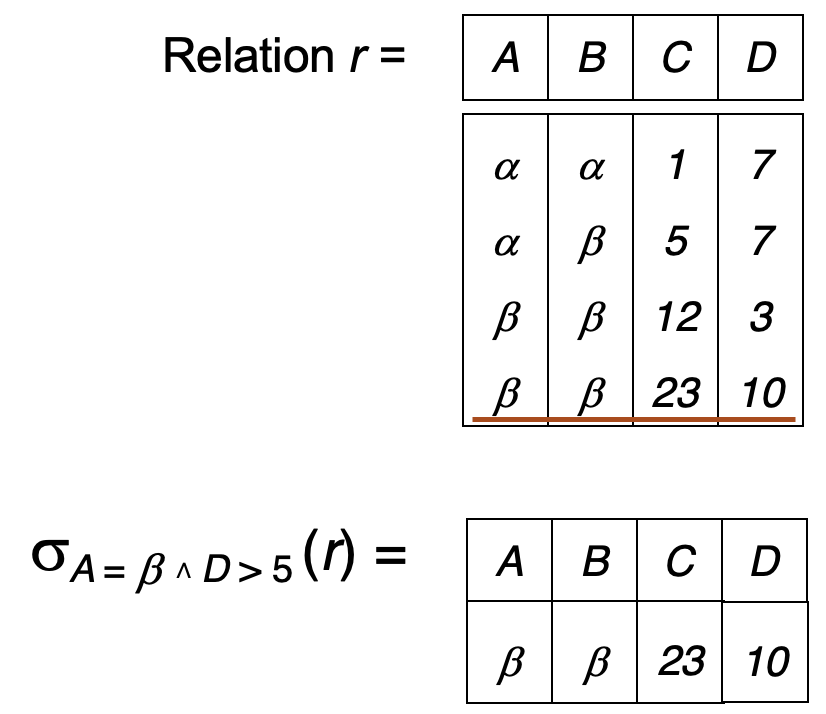
Projection¶
\( \Pi_{A_1, A_2, \ldots, A_k} (r) \)
- \( r \) is a relation
- \( A_i \) is an attribute of \( r \)
The result is defined as the relation of \(k\) columns obtained by erasing the columns that are not listed. 结果是通过删除未列出的列而获得的 \(k\) 列关系。并且进行 去重。
Example
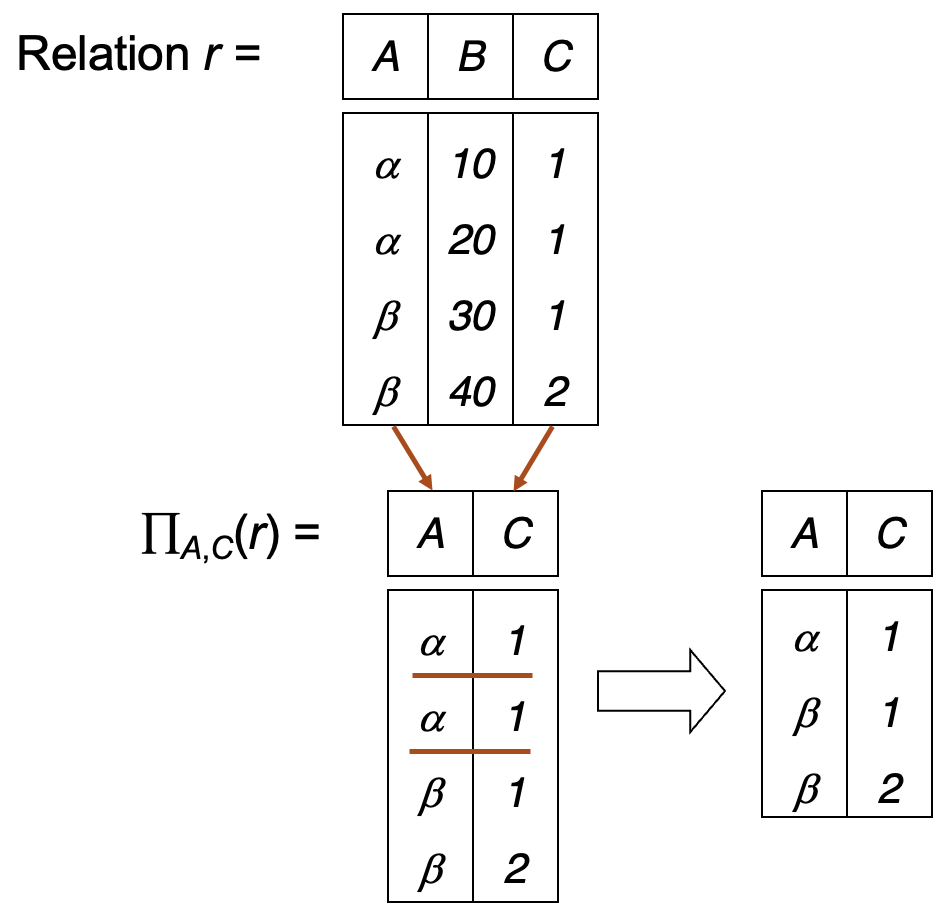
Union¶
\( r \cup s = \{ t \mid t \in r \lor t \in s \} \)
- \( r \) and \( s \) are relations
- \( r \) and \( s \) must have the same number of attributes. \( r \) 和 \( s \) 必须有相同数量的属性。
- The attribute domains must be compatible. 属性域必须兼容。
Example
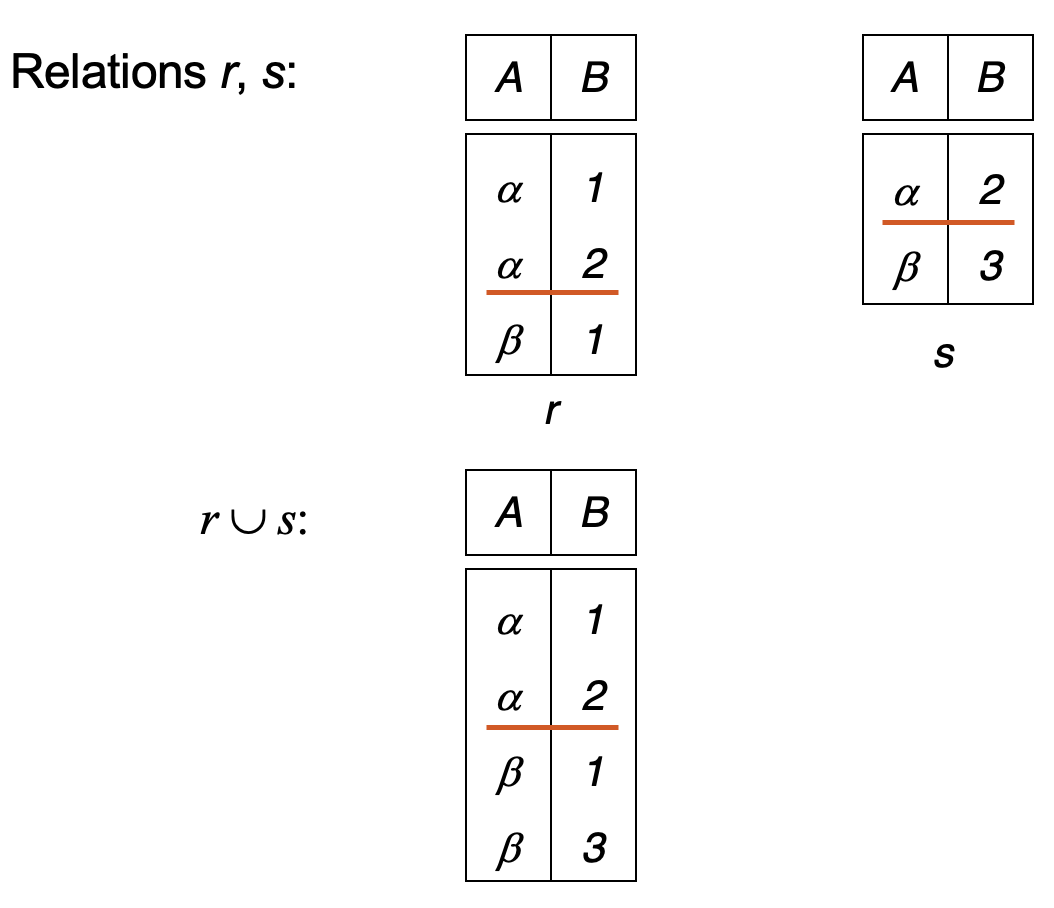
Set Difference¶
\( r - s = \{ t \mid t \in r \land t \notin s \} \)
- \( r \) and \( s \) are relations
- Similar to Union, \( r \) and \( s \) must have the same number of attributes and the attribute domains must be compatible.
Example
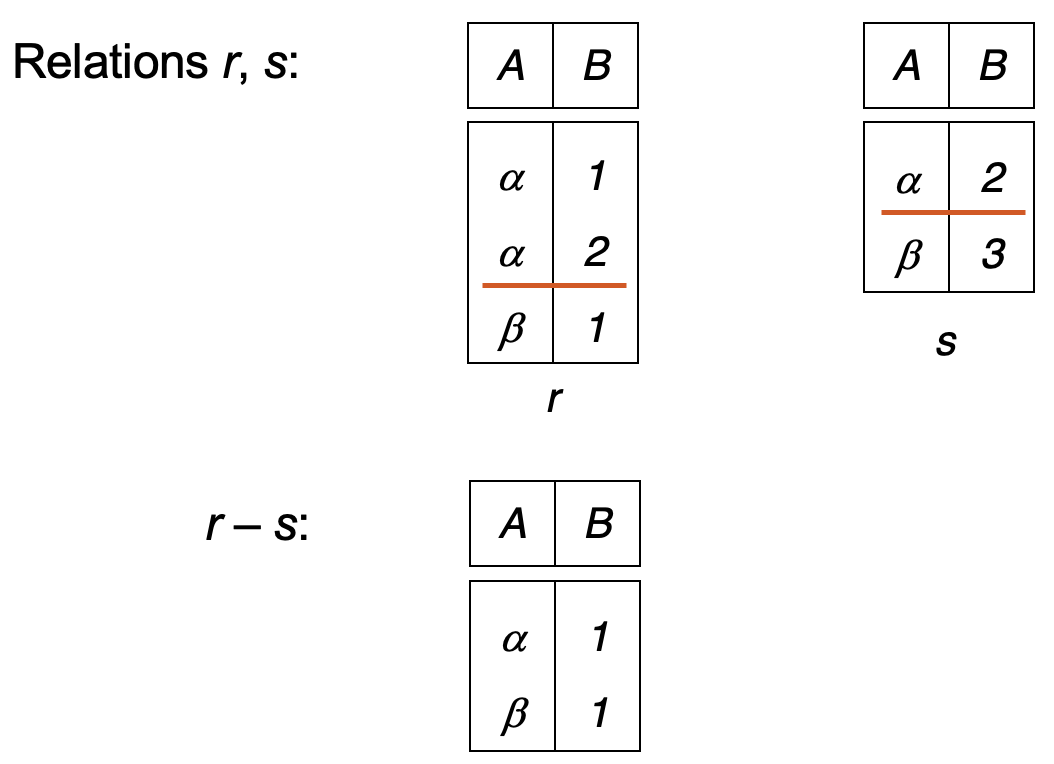
Cartesian Product¶
\( r \times s = \{ (t_1, t_2) \mid t_1 \in r \land t_2 \in s \} \)
- \( r \) and \( s \) are relations
- If \( r \) and \( s \) are not disjoint, then rename will be used to avoid ambiguity between the attributes with the same name. 如果 \( r \) 和 \( s \) 有相同名称的属性,则将使用 重命名 来避免具有相同名称的属性之间的歧义。
Example
\( r \) 和 \( s \) 不相交:
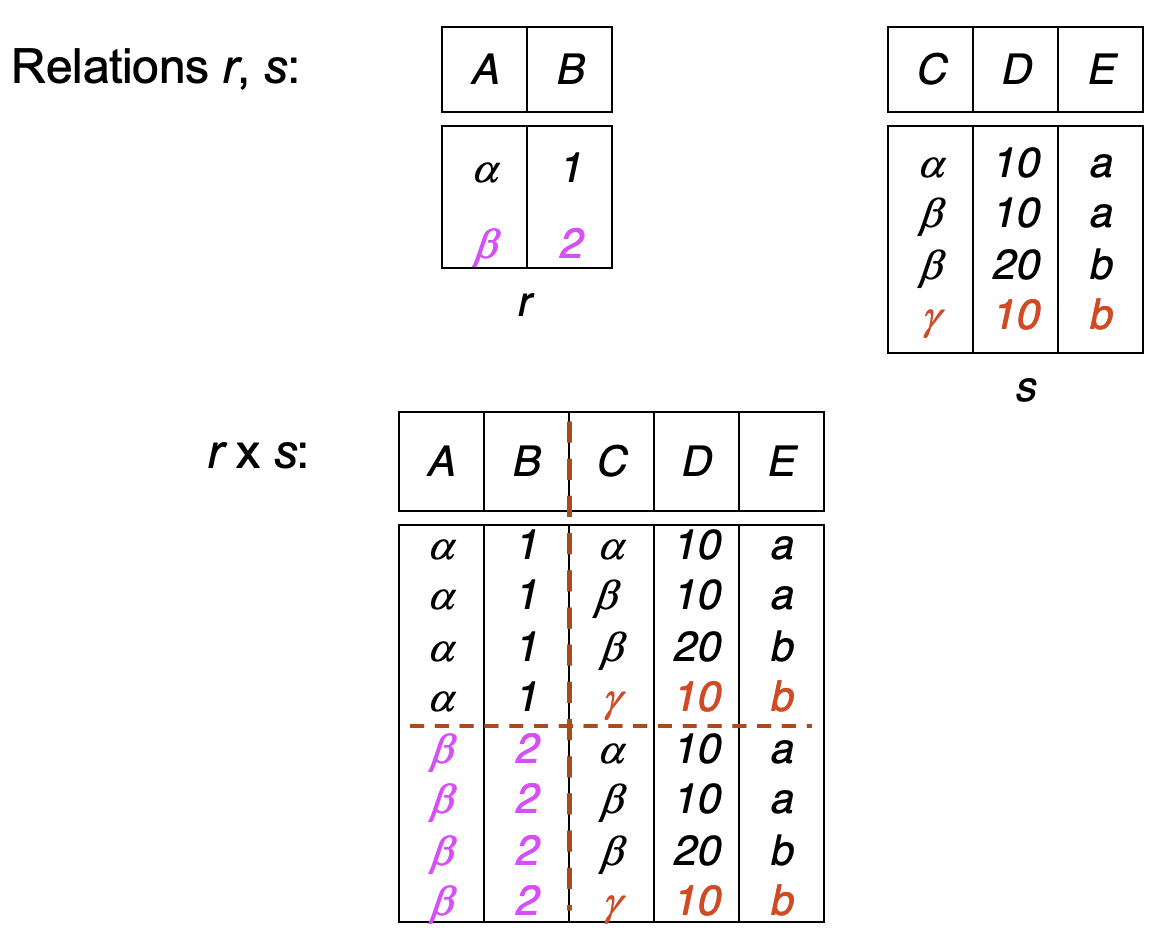
\( r \) 和 \( s \) 相交:
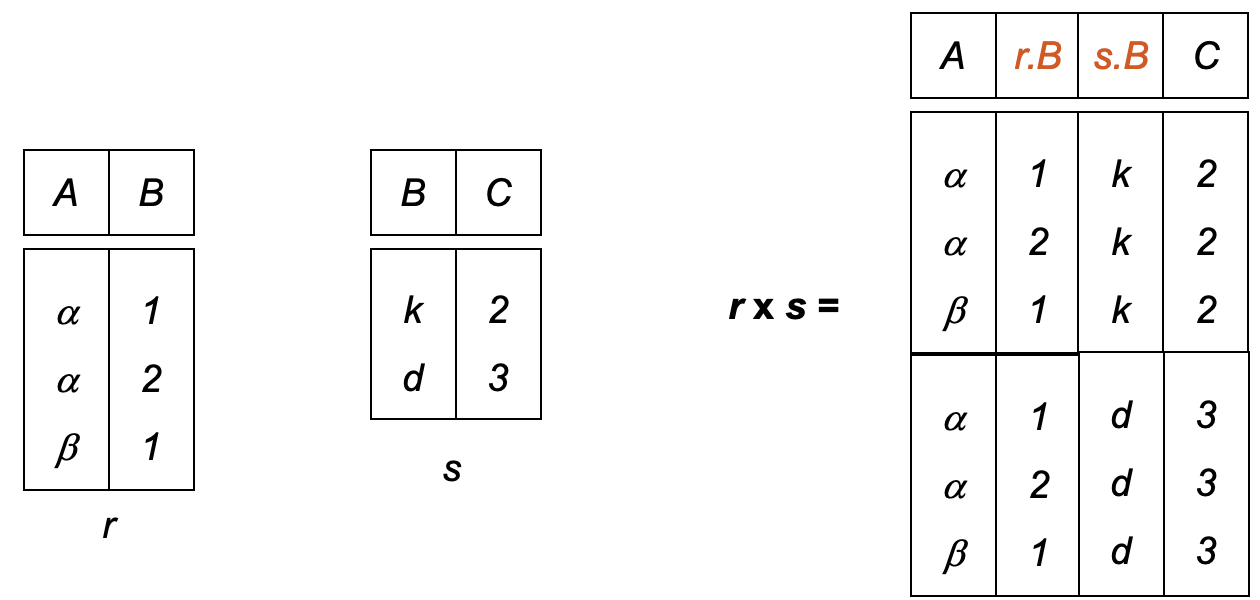
Rename¶
- \( \rho_X (E) \): rename the expression \(E\) as \(X\).
- \( \rho_{X(A_1, A_2, \ldots, A_n)} (E) \): rename the expression \(E\) as \(X\) and the attributes as \(A_1, A_2, \ldots, A_n\).
\( \rho \) returns a relation that is identical to \(E\) except that the relation is renamed as \(X\). \( \rho \) 返回一个与 \(E\) 相同的关系,只是关系被重命名为 \(X\)。
Additional Relational-Algebra Operations¶
Four additional operators:
- Set Intersection: \( \cap \) 交
- Natural Join: \( \bowtie \) 自然连接
- Division: \( \div \) 除
- Assignment: \( \leftarrow \) 赋值
Set Intersection¶
\( r \cap s = \{ t \mid t \in r \land t \in s \} = r - (r - s) \)
- \( r \) and \( s \) are relations
- \( r \) and \( s \) must have the same number of attributes and the attribute domains must be compatible.
Example
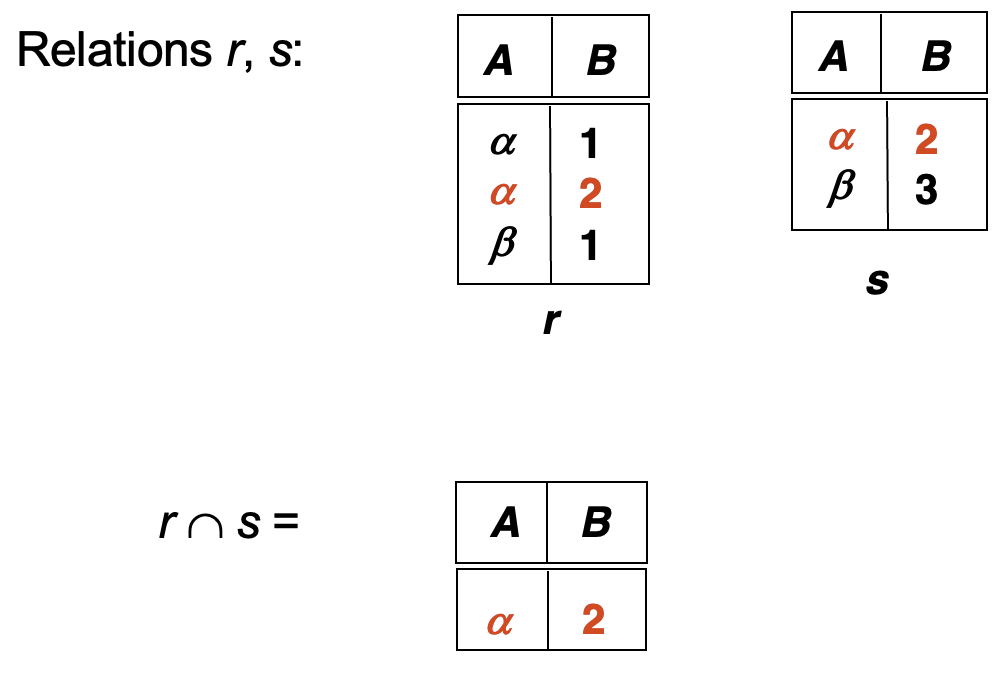
Natural Join¶
\( r \bowtie s \)
- \( r \) and \( s \) are relations
- Consider each pair of tuples \( t_1 \in r \) and \( t_2 \in s \), if \( t_1 \) and \( t_2 \) have the same value on each attribute in \( R \cap S \), then add a tuple to the result relation with the remaining attributes from \( t_1 \) and \( t_2 \). 如果 \( t_1 \) 和 \( t_2 \) 在 \( R \cap S \) 上的每个属性上具有相同的值,则将一个元组添加到结果关系中,该元组具有来自 \( t_1 \) 和 \( t_2 \) 的剩余属性。
Example
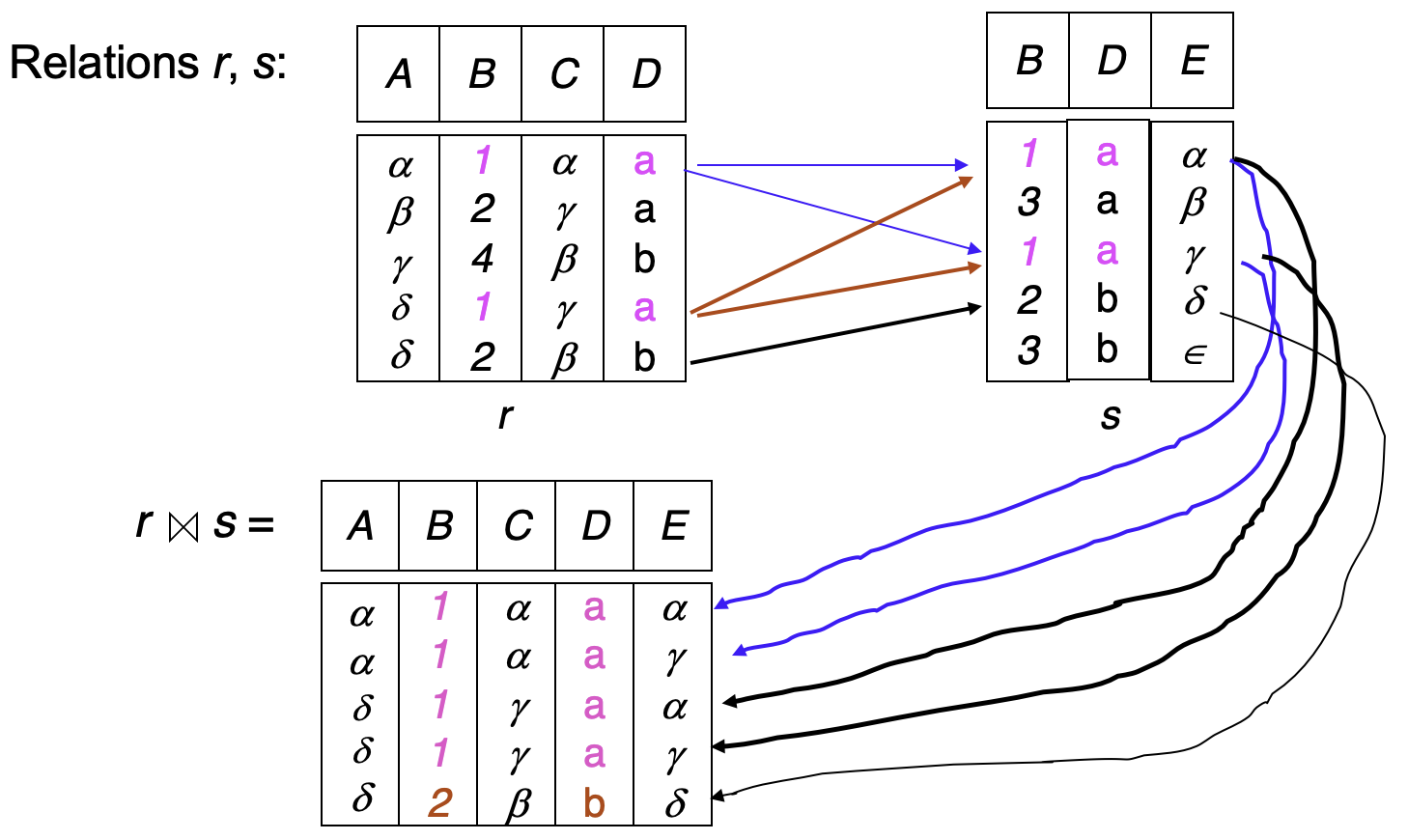
Theta Join Operation
\( r \bowtie_{\theta} s = \sigma_{\theta} (r \times s) \)
Division¶
\( r \div s = \{ t \mid t \in \Pi_{R - S} (r) \land \forall u \in s, t \times u \in r \} \)
- \( r \) and \( s \) are relations on schema \( R and S \)
Example
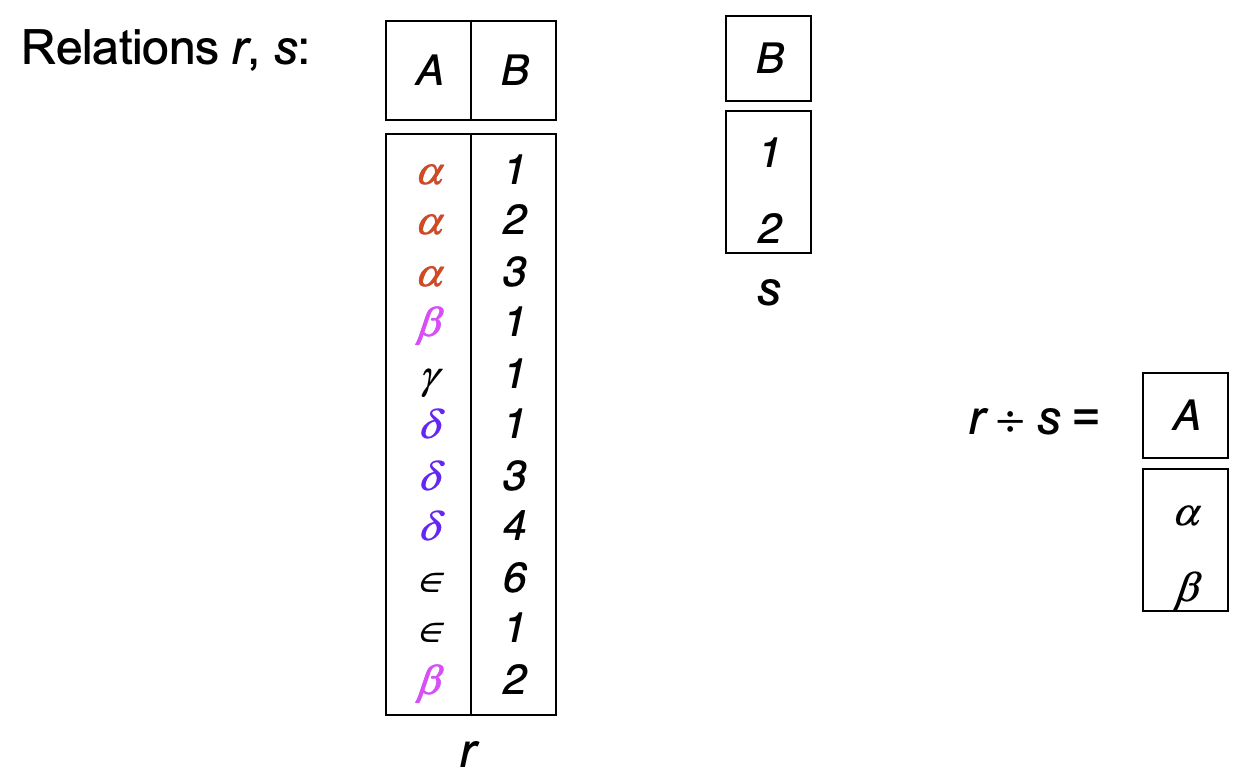
Assignment¶
\( X \leftarrow E \)
Assignment is always made to a temporary relation.
Example
Write \( r \div s \) as:
Extended Relational-Algebra Operations¶
- Generalized Projection: \( \Pi_{A_1, A_2, \ldots, A_n} (r) \) where \( A_i \) is an expression. 广义投影
- Aggregation Functions: 聚合函数
Generalized Projection¶
\( \Pi_{A_1, A_2, \ldots, A_n} (r) \) where \( A_i \) is an expression.
Example
Given a relation \( \text{credit_info}(\text{customer_name}, \text{limit}, \text{current_balance}) \), we can use the following expression to calculate the available credit for each customer:
Aggregation Functions¶
\( _{G_1, G_2, \ldots, G_n}g_{F_1(A_1), F_2(A_2), \ldots, F_n(A_n)} (r) \)
- \( r \) is a relation
- \( A_i \) is an attribute of \( r \)
- \( F_i \) is an aggregation function, such as
- avg: average value
- sum: sum of values
- count: number of tuples
- max: maximum value
- min: minimum value
- \( G_i \) is a grouping attribute(can be empty)
Example
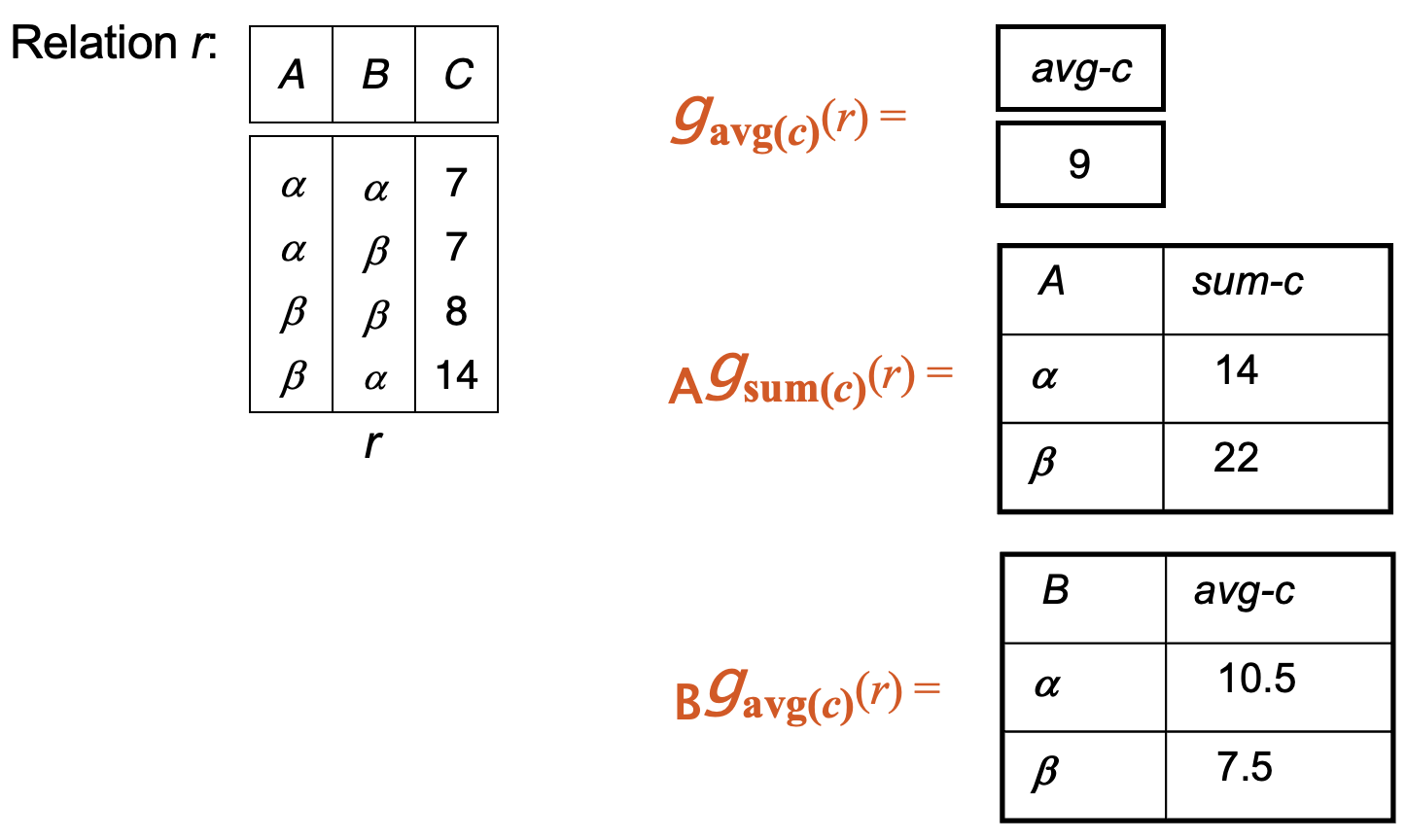
Info
Result of aggregation does not have a name. 聚合的结果没有名称,需要重命名或者在聚合操作中指定名称。
Example:
Modification of the Database¶
- Deletion
- Insertion
- Updating
Deletion¶
\( r \leftarrow r - E \)
- \( r \) is a relation
- \( E \) is a relational-algebra expression
Insertion¶
\( r \leftarrow r \cup E \)
Updating¶
\( r \leftarrow \Pi_{F_1, F_2, \ldots, F_n} (r) \)
- \( r \) is a relation
- \( F_i \) is an attribute of \( r \) or an expression which gives the new value of the attribute